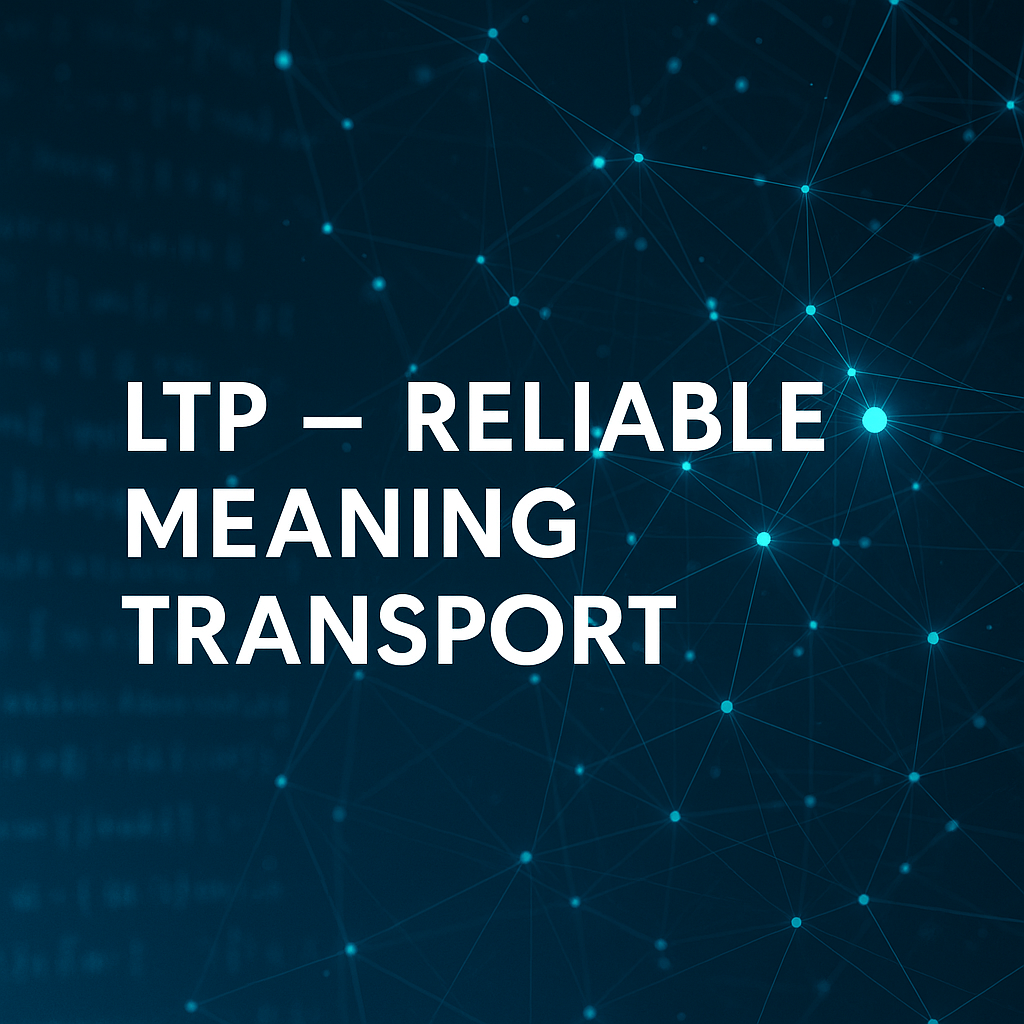— 12-Dimensional Semantic State, EIDBO/KSP Syntax, and the Lagrule Transmission Protocol
Authors: Ionisation (KSP.CITY)
Keywords: semantic networking, EIDBO, KSP, 12-D vector, protocol design, autonomous agents, intent consensus, drift detection
Abstract
We present the Lagrule Transmission Protocol (LTP), a semantics-first protocol that guarantees reliable meaning transport between AI agents and humans across heterogeneous systems. LTP formalizes “intent, emotion, deployment” dynamics via a 12-dimensional semantic state that unifies EIDBO (Emotion/Intention/Deployment/Behavior/Outcome) and KSP (Knowledge/Syntax/Practice). We define packet structure, session control, congestion/flow control by Intent Load, and end-conditions by Meaning Convergence rather than byte ACKs. On top, we specify FlowPack (programmable conversation flows), Drift Watcher (temporal semantic drift), and Re-Genesis (self-improving flows). We discuss security (UUID署名+EIDハッシュ), evaluation protocols, and ethics. A reference implementation (WordPress/KSP StepMail + KSP.CITY stack) demonstrates feasibility at production scale (≈140 docs).
📖 Japanese Version Available: A full Japanese interpretation of this paper is now available.
1. Introduction
The internet solved reliable bit transport; modern AI requires reliable meaning transport. Existing APIs (HTTP/gRPC) ensure delivery but not intent alignment. We propose LTP, a transport/session layer atop TCP/IP that treats meaning as the first-class payload, end-conditions as semantic consensus, and congestion as intent saturation.
Contributions:
- 12-D semantic state that unifies EIDBO and KSP;
- LTP semantics: packet, session, convergence, and flow control;
- System services: FlowPack, Drift Watcher, Re-Genesis;
- Security model for persona/RAG federation;
- A reproducible evaluation protocol on KSP.CITY.
2. Background & Related Concepts
- EIDBO: five axes describing communicative dynamics.
- KSP: Knowledge (記述) / Syntax (構文) / Practice (適用)。
- 12-D State: augments EIDBO(5) + KSP(3) with density, confidence, affect polarities, and similarity anchors to reach 12.
- Flow-centric systems: email flows, chat playbooks, RAG pipelines. None specify a transport semantics for intent. LTP fills this gap.
3. 12-Dimensional Semantic State
Let a document/utterance be a tuple
[
mathbf{s} = langle mathbf{e}, mathbf{k}, d, c, mathbf{a}, sigma rangle
]
where:
- (mathbf{e}inmathbb{R}^5) (EIDBO): (E,I,D,B,O in [0,1]), (sum mathbf{e}=1) (softmax-normalized).
- (mathbf{k}inmathbb{R}^3) (KSP): (K,S,P in [0,1]), (sum mathbf{k}=1).
- (dinmathbb{R}_{ge 0}) (density): structural density (e.g., tokens/claim, or normalized compression length).
- (cin[0,1]) (confidence): discriminability/consistency score.
- (mathbf{a}inmathbb{R}^2) (affect): e.g., valence/arousal or joy–anxiety pair, normalized to ([-1,1]).
- (sigmain[0,1]) (similarity anchor): avg cosine similarity vs. domain anchor set.
This yields 5+3+1+1+2+1 = 12.
Semantic distance between states (mathbf{s}_1,mathbf{s}_2):
[
mathrm{dist}(mathbf{s}_1,mathbf{s}_2)
= lambda_e cdot mathrm{JS}(mathbf{e}_1 Vert mathbf{e}_2)
- lambda_k cdot mathrm{JS}(mathbf{k}_1 Vert mathbf{k}_2)
- lambda_d |d_1-d_2|
- lambda_c |c_1-c_2|
- lambda_a Vert mathbf{a}_1-mathbf{a}_2Vert_2
- lambda_sigma |sigma_1-sigma_2|
]
with (sum lambda_cdot = 1). (JS: Jensen–Shannon divergence)
Drift score (temporal):
[
mathrm{drift}t = mathrm{dist}(mathbf{s}{t}, mathbf{s}_{t-1})
]
Flag drift if (mathrm{drift}_t > theta) (e.g., 0.15).
4. LTP: Lagrule Transmission Protocol
4.1 Design Goals
- End-condition = Meaning Convergence: stop when both sides agree that intent is achieved.
- Flow control by Intent Load: throttle when cognitive saturation is detected.
- Session memory: carry semantic state across turns (FlowPack).
4.2 Packet & Session
LTP Packet
struct LTPPacket {
UUID session_id
uint64 seq
SemanticState s12 // 12-D vector (quantized)
IntentDecl intent // natural language or enum
Payload payload // text/markdown or structured
Meta { persona_id, rag_refs[], tags[], ttl }
Auth { uuid_sig, eid_hash } // integrity & persona binding
}
Session lifecycle
- OPEN: exchange personas + initial s12; negotiate λ weights.
- TRANSFER: payloads with updated s12; each turn recomputes drift & load.
- CONVERGE: compute Meaning Convergence (M).
- CLOSE: archive into Flow Ledger.
Meaning Convergence
[
M = 1 - mathrm{dist}(mathbf{s}text{sender}, mathbf{s}text{receiver})
]
Converged if (M ge tau) (e.g., 0.9) and task constraints satisfied.
Intent Load (L) (congestion proxy)
[
L = alphacdot mathrm{entropy}(mathbf{e}) + betacdot (1-c) + gammacdot d
]
If (L > L_{max}), sender reduces payload granularity or increases step size.
4.3 Reliability & Control
- ACK = Semantic ACK: include receiver’s s12 + task-state hash.
- Retransmission: triggered by drift spikes rather than ACK timeout.
- Backoff: exponential on (L), not on RTO alone.
- Session keys: rotate when persona or rag_scope changes.
4.4 Services atop LTP
- FlowPack: typed, versioned conversational programs
(reconnection,nurture,conversion), serialized as Markdown+YAML with guard-clauses on s12. - Drift Watcher: daily snapshots; alert on phase shift (E↔I↔D…).
- Re-Genesis: periodic re-generation and scoring of FlowPack variants.
5. Algorithms
5.1 s12 Inference (per message)
function infer_s12(text, rag_refs):
e = softmax(EIDBO_classifier(text, rag_refs))
k = softmax(KSP_classifier(text, rag_refs))
d = density_metric(text) // e.g., tokens / claims
c = confidence_metric(text, rag_refs) // entailment consistency
a = affect_estimator(text) // (valence, arousal)
σ = avg_cosine(text, anchor_corpus)
return <e,k,d,c,a,σ>
5.2 Congestion / Flow Control
function compute_intent_load(s12):
(e,k,d,c,a,σ) = s12
H = entropy(e) // phase uncertainty
return αH + β(1-c) + γ*d
function throttle(L):
if L > Lmax:
increase_step_size()
reduce_rag_span()
switch_persona_mode("concise")
5.3 Convergence & Retransmit
function convergence(s_sender, s_receiver):
M = 1 - dist(s_sender, s_receiver)
return (M >= τ) && task_constraints_met()
on_receive(packet):
s_local = infer_s12(packet.payload, rag_scope)
if drift(s_local, last_s_local) > θ:
request_clarification() // semantic NACK
send_semantic_ack(s_local)
6. Security & Trust
- Identity:
uuid_sig = Sig(UUID_session || seq || s12 || hash(payload)). - Integrity:
eid_hash = HMAC(e||k||d||c||a||σ, persona_key). - Scope-binding: persona ↔ rag_scope ↔ API credentials.
- Replay protection: monotonic
seq+ TTL. - Privacy: on-device redaction of PII before LTP encode; persona policies enforce RAG boundaries.
- Forensics: Flow Ledger stores session headers (no raw payload) for audit.
7. Reference Implementation (KSP.CITY Stack)
- Ingress: WordPress (KSP StepMail), REST endpoints, mu-plugins for meta write/inspect.
- Middle: FlowPack executor, Evaluator (open/CTR → S/A/B…), Drift Watcher cron (daily).
- Storage:
wp_ksp_sm_*tables: flow_version, exec_log, eid_history, errorlog. - Ops: circuit breaker, retry/jitter, log rotation, health & metrics.
- Personae: Mentra / Velmara / Ionisation (切替は s12 分布と Intent Load で自動).
8. Evaluation Protocol
Goals: Does LTP improve (a) task success at fewer turns, (b) stability under drift, (c) user-perceived alignment?
Datasets/Tasks
- KSP long-form authoring; email/stepmail flows; tag/SEO synthesis; semantic dashboard ops.
Metrics
- Convergence turns (# of exchanges to (Mgetau)),
- Drift resilience (area under drift curve),
- Task success (human rubric + automated checks),
- Throughput (tokens/time under L constraints).
Baselines
- HTTP+prompt only; tool-augmented chat without s12; fixed-persona flows.
Ablations
- Remove Intent Load; replace convergence with token-length stop; random persona.
Procedure
- 30 sessions × 3 personas × 3 tasks; report mean±sd; paired tests.
9. Ethics & Safety
- No covert logging of raw content; ledger stores headers only.
- Public manifest ≠ internal logs(公開は思想、内部は構造)— 分離原則。
- Consent & purpose limitation on RAG corpora; redaction at ingress.
- Audit hooks for “who changed persona/rag_scope/weights”.
10. Limitations & Future Work
- s12 depends on classifier calibration; cross-domain drift needs adaptive anchors.
- Multi-agent consensus beyond dyads (federation) → LTP-Consensus(Raft類似の意味合意)。
- Hardware/edge LLMs: LTP over local meshes; offline caching of FlowPacks.
11. Conclusion
LTP reframes “communication” as meaning transport with semantic guarantees. By formalizing a 12-D state, convergence, and intent-aware flow control, it provides a practical substrate for AI–human networks. Our reference stack shows production viability; the protocol is ready for federation experiments (KSP Network).
Appendix A. Minimal Wire Format (JSON-lines)
{"type":"OPEN","session":"UUID","s12":{...},"persona":"Ionisation","rag":["uri:..."],"sig":"..."}
{"type":"DATA","seq":1,"s12":{...},"payload":{"md":"..."},"tags":["ksp","eid"],"sig":"..."}
{"type":"SACK","seq":1,"s12":{...},"M":0.87,"constraints":{"todo":"remain"},"sig":"..."}
{"type":"CLOSE","summary":{"M":0.93,"turns":7},"ledger_ref":"...","sig":"..."}
Appendix B. Pseudocode: FlowPack (YAML+MD)
meta:
id: flow.nurture.v3
persona: Velmara
converge: M>=0.9 && deliverables>=2
guards:
- if L > 0.65 then step_size = "coarser"
- if drift > 0.15 then ask: "要点の再同期"
steps:
- md: "前提の合意を3行で要約してください。"
- md: "KSP視点で骨子→各節見出し→タスク配分を提案。"
- md: "EIDBO配分と根拠を明示。"
Appendix C. Notation Summary
- ( mathrm{JS} ): Jensen–Shannon divergence
- (M): Meaning Convergence score
- (L): Intent Load (congestion proxy)
- (theta): drift threshold, (tau): convergence threshold

